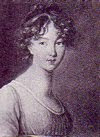 The second purse is knit and now I have to weave in or use the ends in the decoration at both ends. It is still a little bulky so I have started another one in embroidery thread (at right) hoping to achieve a result that will more closely resemble silk. The Nelson purse (awaiting finishing touches) is on the left. Both still need their rings, as well.
The second purse is knit and now I have to weave in or use the ends in the decoration at both ends. It is still a little bulky so I have started another one in embroidery thread (at right) hoping to achieve a result that will more closely resemble silk. The Nelson purse (awaiting finishing touches) is on the left. Both still need their rings, as well.
Friday, 23 May 2008
Miser's Purses In Progress
 The second purse is knit and now I have to weave in or use the ends in the decoration at both ends. It is still a little bulky so I have started another one in embroidery thread (at right) hoping to achieve a result that will more closely resemble silk. The Nelson purse (awaiting finishing touches) is on the left. Both still need their rings, as well.
The second purse is knit and now I have to weave in or use the ends in the decoration at both ends. It is still a little bulky so I have started another one in embroidery thread (at right) hoping to achieve a result that will more closely resemble silk. The Nelson purse (awaiting finishing touches) is on the left. Both still need their rings, as well.
Subscribe to:
Post Comments (Atom)


3 comments:
Hello, a friend showed me your Master & Commander miniatures, and I ended up here....
I have a book on Nelson's purse ("Nelson's purse" by Martyn Downer; interesting read) and from th ephotographs I would say that it is actually made using a technique called 'sprang', even though it is described as a netted purse, and then the author talks about purses being knitted. The things which lead me to think that it is sprang are: the bumps on the surface form diagonal lines, and the curled loops of thread at the ends of the pouch.
Anyway, lovely and fun knitting projects here!
Thank you for your comments. I based my reproduction on the purse in Downer's book. Downer is inconsistent in his description of the technique used to make the purse. I am planning to comment on his book when I post the photograph of the finished purses.
I like the idea of sprang and question it only because I wonder how widespread sprang was in England at this time. Of course, we do not really know the origin of the purse. Nelson or someone else could have purchased or been given the purse anywhere in the world. I cannot agree with Downer that Fanny Nelson made it without more documentation on her behalf.
And now I have written much of what I am going to put into the next Nelson purse post! May I use your suggestion of sprang in it?
Sorry, it has been a while since I checked back here.
Of course you can use the sprang suggestion. I'm all for spreading the word on historic textiles!
From about 1700 onwards sprang was being used for military sashes (George Washington's survives, from about 1779). From "The the techniques of sprang" by Peter Collingwood. He says that British sashes were dark crimson, but not much else. So that puts it as a possible, but not definite.
Totally agree with youe comments on Downer's book- it illustrates the problems of somebody who doesn't realise the differences between techniques!
Post a Comment